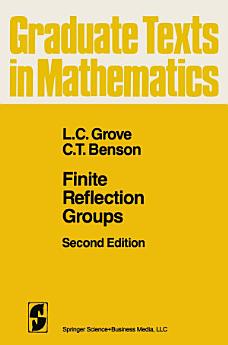Finite Reflection Groups: Edition 2
L.C. Grove · C.T. Benson
মাৰ্চ ২০১৩ · Graduate Texts in Mathematics কিতাপ 99 · Springer Science & Business Media
ইবুক
136
পৃষ্ঠা
reportমূল্যাংকন আৰু পৰ্যালোচনা সত্যাপন কৰা হোৱা নাই অধিক জানক
এই ইবুকখনৰ বিষয়ে
Chapter 1 introduces some of the terminology and notation used later and indicates prerequisites. Chapter 2 gives a reasonably thorough account of all finite subgroups of the orthogonal groups in two and three dimensions. The presentation is somewhat less formal than in succeeding chapters. For instance, the existence of the icosahedron is accepted as an empirical fact, and no formal proof of existence is included. Throughout most of Chapter 2 we do not distinguish between groups that are "geo metrically indistinguishable," that is, conjugate in the orthogonal group. Very little of the material in Chapter 2 is actually required for the sub sequent chapters, but it serves two important purposes: It aids in the development of geometrical insight, and it serves as a source of illustrative examples. There is a discussion offundamental regions in Chapter 3. Chapter 4 provides a correspondence between fundamental reflections and funda mental regions via a discussion of root systems. The actual classification and construction of finite reflection groups takes place in Chapter 5. where we have in part followed the methods of E. Witt and B. L. van der Waerden. Generators and relations for finite reflection groups are discussed in Chapter 6. There are historical remarks and suggestions for further reading in a Post lude.
এই ইবুকখনক মূল্যাংকন কৰক
আমাক আপোনাৰ মতামত জনাওক।
পঢ়াৰ নির্দেশাৱলী
স্মাৰ্টফ’ন আৰু টেবলেট
Android আৰু iPad/iPhoneৰ বাবে Google Play Books এপটো ইনষ্টল কৰক। ই স্বয়ংক্রিয়ভাৱে আপোনাৰ একাউণ্টৰ সৈতে ছিংক হয় আৰু আপুনি য'তে নাথাকক ত'তেই কোনো অডিঅ'বুক অনলাইন বা অফলাইনত শুনিবলৈ সুবিধা দিয়ে।
লেপটপ আৰু কম্পিউটাৰ
আপুনি কম্পিউটাৰৰ ৱেব ব্রাউজাৰ ব্যৱহাৰ কৰি Google Playত কিনা অডিঅ'বুকসমূহ শুনিব পাৰে।
ই-ৰীডাৰ আৰু অন্য ডিভাইচ
Kobo eReadersৰ দৰে ই-চিয়াঁহীৰ ডিভাইচসমূহত পঢ়িবলৈ, আপুনি এটা ফাইল ডাউনল’ড কৰি সেইটো আপোনাৰ ডিভাইচলৈ স্থানান্তৰণ কৰিব লাগিব। সমৰ্থিত ই-ৰিডাৰলৈ ফাইলটো কেনেকৈ স্থানান্তৰ কৰিব জানিবলৈ সহায় কেন্দ্ৰত থকা সবিশেষ নিৰ্দেশাৱলী চাওক।







